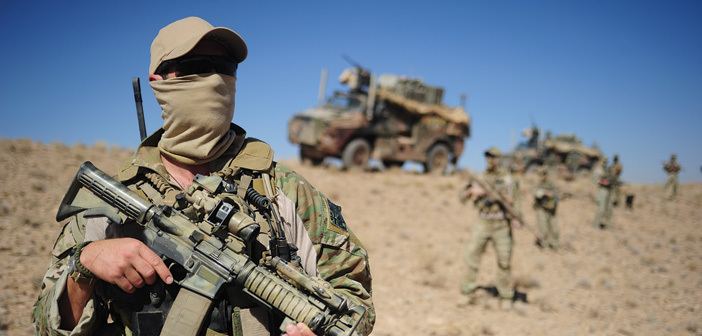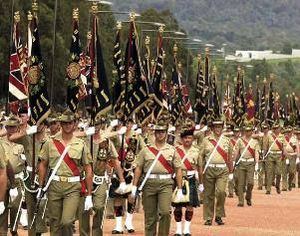Active 1 March 1901 – present Type Army | Website www.army.gov.au | |
Size 28,568 (Regular)14,662 (Active Reserve) Commander-in-chief Elizabeth II, Queen of Australia, represented by General Sir Peter CosgroveAs Governor-General of Australia Similar Australian Defence Force, Royal Australian Air Force, Royal Australian Navy, First Australian Imperial F, British Army Profiles | ||
Wwi factions the australian army
The Australian Army is Australia's military land force. It is part of the Australian Defence Force (ADF) along with the Royal Australian Navy and the Royal Australian Air Force. While the Chief of the Defence Force (CDF) commands the ADF, the Army is commanded by the Chief of Army (CA). The CA is therefore subordinate to the CDF, but is also directly responsible to the Minister for Defence. Although Australian soldiers have been involved in a number of minor and major conflicts throughout its history, only in World War II has Australian territory come under direct attack.
Contents
- Wwi factions the australian army
- History
- Current organisation
- 1st Division
- Forces Command
- Special Forces
- Planned restructuring
- Colours standards and guidons
- Strength
- Rank and insignia
- Bases
- Australian Army Journal
- Future procurement
- References
History

Formed in March 1901, with the amalgamation of the six separate colonial military forces, the history of the Australian Army can be divided into two periods:


During its history the Australian Army has fought in a number of major wars, including: Second Boer War (1899–1902), First World War (1914–18), the Second World War (1939–45), Korea War (1950–53), Malayan Emergency (1950–60), Indonesia-Malaysia Confrontation (1962–66), Vietnam War (1962–73), and more recently in Afghanistan (2001 – present) and Iraq (2003–09). Since 1947 the Australian Army has also been involved in many peacekeeping operations, usually under the auspices of the United Nations, however the non-United Nations sponsored Multinational Force and Observers in the Sinai is a notable exception. Australia's largest peacekeeping deployment began in 1999 in East Timor, while other ongoing operations include peacekeeping on Bougainville, in the Sinai, and in the Solomon Islands. Humanitarian relief after 2004 Indian Ocean earthquake in Aceh Province, Indonesia, Operation Sumatra Assist, ended on 24 March 2005.
Current organisation

The 1st Division comprises a deployable headquarters, while 2nd Division under the command of Forces Command is the main home-defence formation, containing Army Reserve units. 2nd Division's headquarters only performs administrative functions. The Australian Army has not deployed a divisional-sized formation since 1945 and does not expect to do so in the future.
1st Division
1st Division carries out high-level training activities and deploys to command large-scale ground operations. It does not have any combat units permanently assigned.
Forces Command
Forces Command controls for administrative purposes all non-special-forces assets of the Australian Army. It is neither an operational nor a deployable command.
Additionally, Forces Command includes the following training establishments:
Special Forces
Special Operations Command comprises a command formation of equal status to the other commands in the ADF. It includes all of Army's special forces assets.
Planned restructuring
Under a restructuring program known as Plan Beersheba announced in late 2011, the 1st, 3rd and 7th Brigades will be re-formed as combined-arms multi-role manoeuvre brigades with the 2nd Battalion, Royal Australian Regiment (part of the 3rd Brigade) forming the core of a future amphibious force. The force will be known as the Amphibious Ready Element and will be embarked on the Navy's new Canberra-class amphibious assault ships.
Colours, standards and guidons
Infantry, and some other combat units of the Australian Army carry flags called the Queen's Colour and the Regimental Colour, known as "the Colours". Armoured units carry Standards and Guidons – flags smaller than Colours and traditionally carried by Cavalry, Lancer, Light Horse and Mounted Infantry units. The 1st Armoured Regiment is the only unit in the Australian Army to carry a Standard, in the tradition of heavy armoured units. Artillery units' guns are considered to be their Colours, and on parade are provided with the same respect. Non-combat units (combat service support corps) do not have Colours, as Colours are battle flags and so are only available to combat units. As a substitute, many have Standards or Banners. Units awarded battle honours have them emblazoned on their Colours, Standards and Guidons. They are a link to the unit's past and a memorial to the fallen. Artillery do not have Battle Honours – their single Honour is "Ubique" which means "Everywhere" – although they can receive Honour Titles.
The Army is the guardian of the National Flag and as such, unlike the Royal Australian Air Force, does not have a flag or Colours. The Army, instead, has a banner, known as the Army Banner. To commemorate the centenary of the Army, the Governor General Sir William Deane, presented the Army with a new Banner at a parade in front of the Australian War Memorial on 10 March 2001. The Banner was presented to the Regimental Sergeant Major of the Army (RSM-A), Warrant Officer Peter Rosemond.
The Army Banner bears the Australian Coat of Arms on the obverse, with the dates "1901–2001" in gold in the upper hoist. The reverse bears the "rising sun" badge of the Australian Army, flanked by seven campaign honours on small gold-edged scrolls: South Africa, World War I, World War II, Korea, Malaya-Borneo, South Vietnam, and Peacekeeping. The banner is trimmed with gold fringe, has gold and crimson cords and tassels, and is mounted on a pike with the usual British royal crest finial.
Strength
In the 2014–15 financial year the Army had an average strength of 43,667 personnel: 29,366 permanent (regular) and 14,301 active reservists (part-time). In addition, there are another 12,496 members of the Standby Reserve. The regular Army is targeted to expand to 30,464 (regular) and 15,250 (part-time) personnel by 2015–16. Personnel numbers have trended upwards since a peak in 2010–11 with an actual strength of 29,366 full-time personnel. Army Reserve numbers are 14,301, which does not include Standby Reserves. This gives the Army a combined strength of 43,667 active personnel for the year 2014–15.
Rank and insignia
The ranks of the Australian Army are based on the ranks of the British Army, and carry mostly the same actual insignia. For officers the ranks are identical except for the shoulder title "Australia". The Non-Commissioned Officer insignia are the same up until Warrant Officer, where they are stylised for Australia (for example, using the Australian, rather than the British coat of arms). The ranks of the Australian Army are as follows:
- Private (PTE) – OR-2
- Private Proficient (PTE(P)) Also used within the Private equivalent ranks – OR-3
- Lance Corporal or Lance Bombardier (LCPL or LBDR) – OR-4
- Corporal or Bombardier (CPL or BDR) – OR-5
- Sergeant (SGT) – OR-6
- Staff Sergeant (SSGT) – OR-7 (SSGT is being phased out of the Australian Army)
- Warrant Officer Class Two (WO2) – OR-8
- Warrant Officer Class One (WO1) – OR-9
- Regimental Sergeant Major of the Army (RSM-A) – OR-9 (This is an appointment rather than a rank)
- Second Lieutenant (2LT) – OF-1
- Lieutenant (LT) – OF-2
- Captain (CAPT) – OF-3
- Major (MAJ) – OF-4
- Lieutenant Colonel (LTCOL) – OF-5
- Colonel (COL) – OF-6
- Brigadier (BRIG) – OF-7. Like the United Kingdom, prior to 1922 Australia used the rank Brigadier General
- Major General (MAJGEN) – OF-8
- Lieutenant General (LTGEN) – OF-9
- General (GEN) – OF-10
- Field Marshal (FM) – OF-11. This rank is generally reserved for wartime and ceremonial purposes; there are no regular appointments to the rank. Sir Thomas Blamey is the only Australian-born officer promoted to the rank. Prince Philip, Duke of Edinburgh, is currently the only living holder of the rank of Field Marshal in the Australian Army. The Duke, however, does not have any active role in the Australian command structure.
Bases
The Army's operational headquarters, Forces Command, is located at Victoria Barracks in Sydney. The Australian Army's three regular brigades are based at Robertson Barracks near Darwin, Lavarack Barracks in Townsville and Gallipoli Barracks in Brisbane. The Deployable Joint Force Headquarters is also located at Gallipoli Barracks.
Other important Army bases include the Army Aviation Centre near Oakey, Queensland, Holsworthy Barracks near Sydney, Lone Pine Barracks in Singleton, New South Wales and Woodside Barracks near Adelaide, South Australia. The SASR is based at Campbell Barracks Swanbourne, a suburb of Perth, Western Australia.
Puckapunyal north of Melbourne houses the Australian Army's Combined Arms Training Centre, Land Warfare Development Centre, and three of the five principal Combat Arms schools. Further barracks include Steele Barracks in Sydney, Keswick Barracks in Adelaide, and Irwin Barracks at Karrakatta in Perth. Dozens of Australian Army Reserve depots are located across Australia.
Australian Army Journal
Since 1948, the Australian Army has published its own journal titled the Australian Army Journal. Covering a broad range of topics including essays, book reviews and editorials, with submissions from serving members as well as professional authors, the journal's stated goal is to provide "...the primary forum for Army's professional discourse... [and to facilitate]... debate within the Australian Army ...[and raise] ...the quality and intellectual rigor of that debate by adhering to a strict and demanding standard of quality". In 1976, the journal was placed on hiatus; however, publishing began again in 1999 and since then the journal has been published largely on a quarterly basis, with only minimal interruptions.
Future procurement
This list includes equipment currently on order or a requirement which has been identified:
